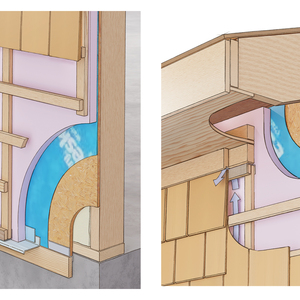Hi:
I’m looking for some ideas/designs/sites regarding making interior storm windows and insulating shutters. Has anyone come across something that works well with out causing lot of condensation on the panes?
– Ron C
“When you’re walking on thin ice . . .
you might as well dance.”



















Replies
Ron, I was with you there till the last sentence. For no condensation, the shutters must seal bulb weatherstrip tight like the Pella interior glass panel. Any air that makes it into the closed cavity when the shutters are closed will surely condense. IG windows in a radiant home are often susceptible to moisture near the bottom of the pane because of lack of air movement. You seal it good and you can probably save some btu's dry-ly. The same would go for an interior glass storm. best of luck.
Just for a side bit of information. The 1860 house on the street by us has thick brick walls. Probably at least a foot. They have the neatest interior shutters I have ever seen. Open, they form a recessed panel "jamb", folding into the the depth of the window opening. Really beautiful. I'll try to get permission to take a shot of the window and post it in the arch. details folder.
__________________________________________
Remodeling Contractor just outside the Glass City.
http://www.quittintime.com/
Hey Cal,
I'd really love to see a pic of those interior shutters.
I kinda thought for my old house of using velcro on the outside just on the inside of the exterior window trims on a 3/4" wood strip nailed up first (and painted to match the trim)..then velcro on a piece of 1/4" plex glass and installing them all from the inside without the need for ladders. (using a suction cup tool)
I may just make one or two this winter and try them out...see how the look and work.
a"Attachment is the strongest block to realization"http://CLIFFORDRENOVATIONS.COM
One house that I seen the person has put magnetic storms inside the house that worked for him.
He got a hold of magnetic ribbon 1/8 thick 3/4 wide.
He took the casing off the window and plowed a 3/4 dado 3/32 deep in them glued the ribbon in the dado.
Add a stop on top of the stool with a dado for the ribbon.
Using lacquer white paint the casing and ribbon.
Then using a piece of thing polycarbonate (3/32 I think he said) he glued magnetic ribbon on to that also so it would attract to give it more sticking power.
Being the polycarbonate is thin and flexible along with the magnate ribbon it give you close to air tight seal.
He also so mounted a ceiling fan in the center of the room and barely turns. . They also redid the drapes by widening out the rod so the drapes when open show off the casing of the windows. Also moved the drapes a way from the wall so he now has 2" air flow behind the drapes. The windows are frost free now.
I don’t really like the looks of magnate storms
Fredsmart:
The magnet idea seems great. Hope I can make it fit without many air gaps!
- Ron C
We replaced the miniblinds with the cellular shades that open up into rectangular tubes. They really cut down on heat loss and condensation, so much that I have put off building storm windows for this winter.
I was surfing around the web earlier today and saw a site that showed how someone quickly made interior storm windows for about $25 per window (materials only). It's a basic wooden frame with some of that plastic window film that shrinks tight when you heat it with a hair dryer. The edges use folded plastic as a weather strip. It's held in place with a couple of simple cleats. The fit doesn't have to be perfect, because the weather stripping around the edge makes a nice seal.
It looks like a nice, cheap solution that I'm considering using on my own house. If you store it safely, it can be used season after season.
The website is hammerzone.com, and the direct link to the article is: http://www.hammerzone.com/archives/energy/conservation/basics_1/window_cover.htm
Hope this helps.
Interesting......I considered making interior storms of plex glass with velcro strips and using them on the xterior but installed from the interior with suction cups like glazers use.
I found a company that sells dozens of different color velcro and different weather tight strenghts.
The plexi would sit inside the exterior trim....
Lot more money then that guys idea you posted but much more substantial and no frame required unless you feel the need.....
Just a thought I keep thinking about and just may do when I get time..HA!
Be warm
Namaste
Andy"Attachment is the strongest block to realization"http://CLIFFORDRENOVATIONS.COM
That's a neat idea.
I'm trying to picture how the seal around the plexiglass would work in your idea for the external plexiglass storm window. Would the velco be a substitute for weatherstripping? If you have a continuous strip of velcro around the perimeter of the entire sheet of plexiglass, it might work as weatherstripping, but I bet it would take a considerable amount of force to put in place and to remove. If you just did short strips of velco here and there, you would need some sort of weatherstripping too. How would you attach the velcro to the plexiglass so it wouldn't come off when you tried to pull the storm window off? Construction adhesive might work on the plexiglass, but I don't know if it would stick well to the backside of the velcro. I was also a little concerned about the longevity of the velcro that will be stuck to the outside of your house year-round. That stuff has a way of getting full of dirt, clogging, and then not working too well.
You should go with your idea of trying a test window or two for a season before doing a whole house.
Dan
I looked on line at Velcro suppiers and they come in many colors and strengths so when you remove the storm the "self adhesive velcro strip" wouldnt be all that noticeable.
On the plexi glass side facing the street I plan on painting the plexi the width of the strip and the color of the house trim
I thought of using the suction cups glazers use to put in and take out the plexi or just fasten four small knobs to the inside of the storms with screws drilled through the plexi
a"Attachment is the strongest block to realization"http://CLIFFORDRENOVATIONS.COM
I have fixed glass windows (made from sliding glass door panels) and wanted more insulation. Came up with essentially the same idea he did. I used half lap corner joints (faster and stronger, I think) and did not use a horizontal center bar. I used stick on foam for the edge sealing, which takes some reasonably careful measuring, but will probably try his 'plastic' idea if I make more. They are WAY cheaper than $25 each, using pine, and work great. Unless you have REALLY drafty windows, as he apparently has <G>, you won't need cleats, either.
HTHThon